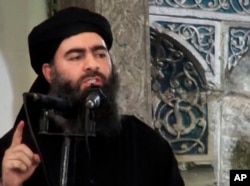Not much is known about the Islamic State in the Greater Sahara, the group that claimed responsibility for killing four U.S. and four Nigerien soldiers in western Niger last October.
However, the group's leader, Adnan Abu Walid al-Sahrawi, is a well-known figure in regional jihadist circles.
Al-Sahrawi "is a longtime veteran of the West African subregion with deep networks in Mali," according to Jacob Zenn, fellow of African and Eurasian Affairs for the Jamestown Foundation in Washington and a consultant on countering violent extremism. "He is able to manage groups of multiple ethnicities that engage in both terrorist attacks and criminal activity."
Al-Sahrawi was once a commander for Al-Qaida in the Islamic Maghreb, where he became associated with Mokhtar Belmokhtar, the one-eyed leader of the group.
Later in 2011, al-Sahrawi was one of the extremists who came together to form the Movement for Oneness and Jihad in West Africa, MUJAO, one of the jihadist groups that seized control of northern Mali for several months in 2012.
In 2015, al-Sahrawi issued a bay'a, or pledge of allegiance, to Abu Bakr al-Baghdadi, the overall leader of the Islamic State militant network.
According to Zenn, al-Sahrawi still has connections to many of the AQIM sub-groups in Mali because of his experiences. But his loyalty is to the Islamic State.
ISGS operational capacities
On September 1, 2016, ISGS fighters attacked a gendarmerie post in Burkina Faso, just across the border from Niger, where they killed two guards. A month later, ISGS killed three policemen in an attack on a police outpost just a few kilometers from the Malian border in Burkina Faso.
Perhaps the most brazen attack by ISGS before the ambush of the U.S. soldiers at Tongo Tongo was the attempted jailbreak at a high-security prison in Niamey, Niger. The prison held suspected Boko Haram militants and other Islamists from the Sahel and Sahara regions.
Weeks after the attempted jailbreak and more than a year after the pledge of allegiance by al-Sahrawi, IS officially acknowledged the bay'a.
But even with the notoriety that came with killing the American and Nigerien soldiers in October 2017, ISGS has limited capabilities.
Zenn said the group "is able to engage small-scale confrontations with conventional militaries, as well as small-scale asymmetric kidnappings," but the group has a limited number of fighters. "Perhaps no more than 200," said Zenn, speaking to VOA last month.
Also, ISGS has no known operational or any other ties to its bigger and more potent Islamist group neighbor, the Islamic State West Africa Province, or the Nigerian militant group Boko Haram, which is also an IS affiliate.
The Islamic State in the Greater Sahara has generally not been able to carry out attacks on hard targets the way AQIM-affiliated groups have in Burkina Faso, Mali and Ivory Coast.
But experts like Zenn believe the group poses a risk to economic targets, like French uranium production sites, and in sparsely populated rural areas.
Niger and its Sahel neighbors formed the military alliance called G5 Sahel to fight ISGS and other extremist groups in the area, while at the same time its military is also fighting Boko Haram along its border with Nigeria and Chad as part of the Lake Chad Multinational Joint Task Force.








